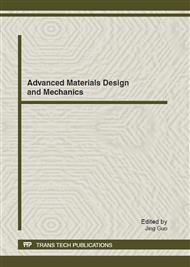[1]
C. H. Bennet and G. Brassard: Proceedings of IEEE International conference on Computers, Systems and Signal Processing, Bangalore, India, IEEE Press, 1984, p.175.
Google Scholar
[2]
A. K. Ekert: Physical Review Letters, 67, 1991, pp.661-663.
Google Scholar
[3]
C. H. Bennett, G. Brassard and N. D. Mermin: Physical Review Letters, 68, 1992, pp.557-559.
Google Scholar
[4]
H. K. Lo and H. F. Chau: Science, 283, 1999, p.2050-(2056).
Google Scholar
[5]
A. Cabello: Physical Review Letters, 85, 2000, pp.5635-5638.
Google Scholar
[6]
P. Xue, C. F. Li and G. C. Guo: Physical Review A, 64, 2001, 032305.
Google Scholar
[7]
X. Y. Li: International Journal of Modern Physics C, 14(6), 2003, pp.757-763.
Google Scholar
[8]
F. G. Deng and G. L. Long: Physical Review A, 70, 2004, 012311.
Google Scholar
[9]
R. Namiki and T. Hirano: Physical Review A, 74, 2006, 032301.
Google Scholar
[10]
B. Qi, Y. Zhao, X. F. Ma, H-K. Lo, and L. Qian: Physical Review A, 75, 2007, 052304.
Google Scholar
[11]
Y. Adachi, T. Yamamoto, M. Koashi and N. Imoto: Physical Review Letters, 99, 2007, p.180503.
Google Scholar
[12]
Z. Q. Yin, Z. F. Han, F. W. Sun and G. C. Guo: Physical Review A, 76, 2007, 014304.
Google Scholar
[13]
R. Matsumoto: Physical Review A, 76, 2007, 062316.
Google Scholar
[14]
O. Ahonen, M. Mottonen, and J. L. O'Brien: Physical Review A, 78, 2008, 032314.
Google Scholar
[15]
Y. Zhao,B. Qi, H-K. Lo: Physical Review A, 77, 2008, 052327.
Google Scholar
[16]
T. Choi and M. S. Choi: Journal of Physics: Condensed Matter, 20, 2008, p.275242.
Google Scholar
[17]
K. M. Horodecki, P. Horodecki, D. Leung and J. Oppenheim: IEEE Transaction Information Theory, 54(6), 2008, pp.2604-2620.
DOI: 10.1109/tit.2008.921870
Google Scholar
[18]
C. H. Bennett, F. Bessette, G. Brassard, L. Salvail and J. Smolin: Journal of Cryptology, 5(1) , 1992, pp.3-28.
DOI: 10.1007/bf00191318
Google Scholar
[19]
T. Kimura, Y. Nambu, T. Hatanaka, A. Tomita, H. Kosaka and K, Nakamura: eprints: quant-ph/0403104.
Google Scholar
[20]
W. T. Buttler et al.: Physical Review Letters, 81, 1998, pp.3283-3286.
Google Scholar
[21]
X. Y. Li, D. X. Zhang: International Conference on Networking and Digital Society, 1, 2009, pp.25-28.
Google Scholar
[22]
Y. H. Kim, S. P. Kulik and Y. Shih: Physical Review Letters, 86, 2001, pp.1370-1373.
Google Scholar
[23]
C. Cinelli, M. Barbieri, F. De Martini and P. Mataloni: International Journal of Laser Physics, 15(1), 2005, pp.124-128.
Google Scholar
[24]
M. Zukowski, Event-deady-detector Bell experiment via entanglement swapping, Physical Review Letters, 1993, 71(26): 4287-4290.
DOI: 10.1103/physrevlett.71.4287
Google Scholar


